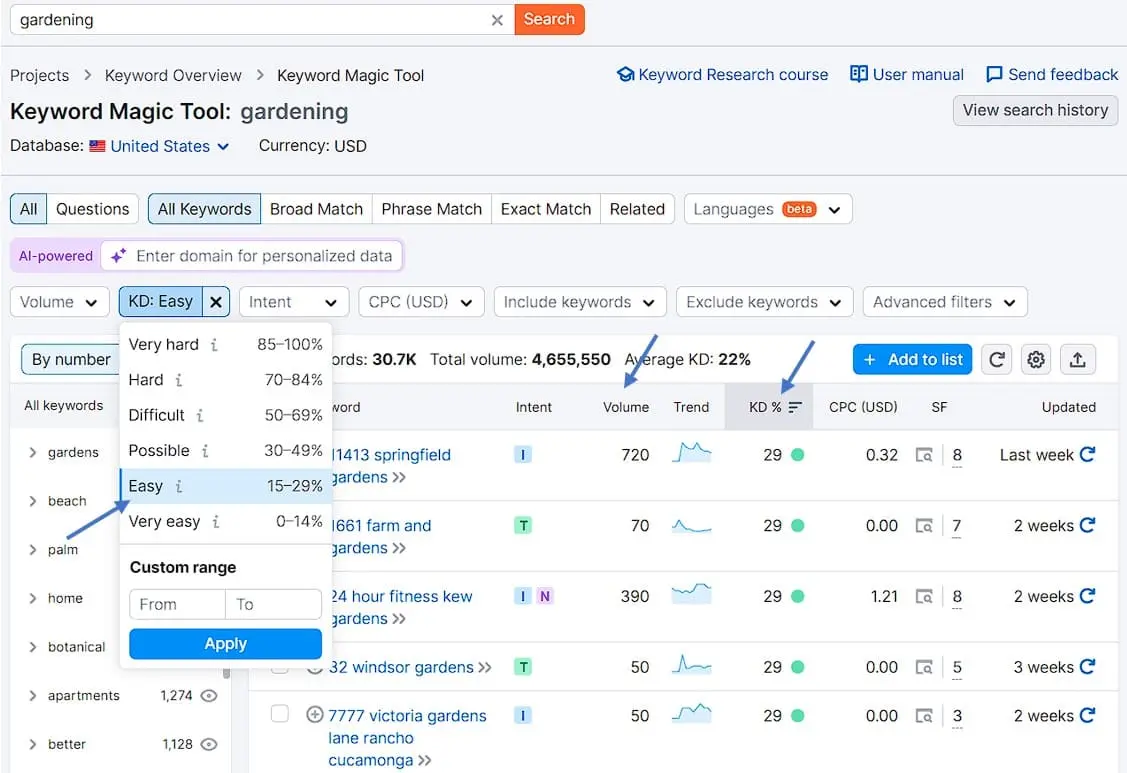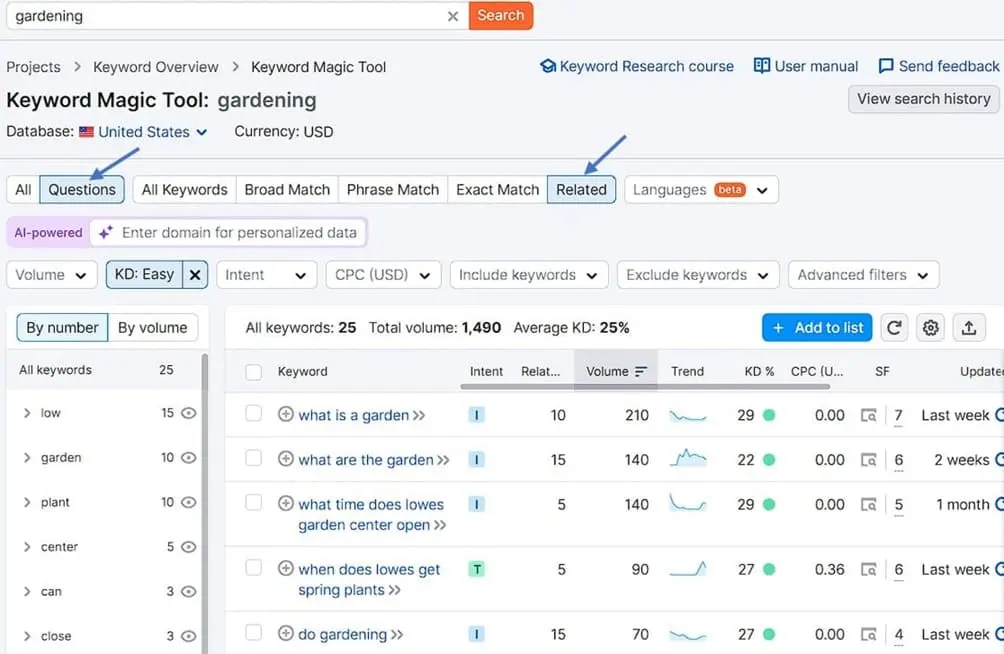Keyword research is a crucial aspect of any successful SEO strategy. When identifying the right keywords to target, one term that often comes up is “low-hanging fruit” keywords. These keywords have decent search volume and low competition levels. Learn how to find low hanging fruit keywords in this article by targeting less competitive words and driving organic traffic to your website.
Understanding Low-Hanging Fruit Keywords
Before understanding how to find low-hanging fruit keywords, we must first understand how to identify these keywords from other competitive keywords. Here are some basic features of low-hanging fruit keywords:
keywords with decent volume
Lower competition level as compared to other competitive keywords
These are often long-tail keywords with a combination of 3-4 words
These are specific and related to your niche
These are sometimes in the form of questions
Why Target Low-Hanging & Low-Competition Keywords?
- It’s easy to Rank for these keywords: Since fewer websites compete for them, you have a better chance of ranking higher in search engine results.
- Faster Results: You can see quicker improvements in your organic traffic as opposed to targeting high-competition keywords.
- Building Authority: Successfully ranking for low-hanging fruit keywords can help you build domain authority over time, making it easier to rank for more competitive keywords in the future.
- Competitive Edge: Targeting low-competition keywords can give you a competitive edge in the online market.
- SEO Success: By identifying and incorporating these keywords into your content, you can improve your chances of SEO success and attract more organic traffic.
How to Find Low Hanging Fruit Keywords
The keyword research process involves identifying the terms and phrases your target audience searches for on the internet. By understanding your audience’s search behaviour, you can tailor your content to meet their needs and improve your website’s visibility in search engine results.
Now, let’s go into deep and understand how to find low-hanging fruit keywords in four easy steps:
Step 1: Conducting Keyword Research
To start the keyword research, first, we have to brainstorm seed keywords and find long tail keywords.
- Brainstorm Seed Keywords: Start by listing broad topics related to your niche. These are your seed keywordsthat describe your business or content. For instance, if you run a blog about gardening, your seed keywords could be “gardening,” “plant care,” and “vegetable gardening.”
- Find Long-Tail Keywords: Once you have your seed keywords, expand them into long-tail keywords. Long-tail keywords are longer and more specific search phrases with lower competition levels. For example, from the seed keyword “gardening,” you could generate long-tail keywords like “organic gardening tips for beginners” or “how to start a vegetable garden in small spaces.”
Here’s why long-tail keywords are effective:
- Specific Intent: They capture user intent, making it easier to meet searchers’ needs.
- Less Competition: Fewer websites target these specific phrases, making it easier for you to rank
- Targeted Organic Traffic: By targeting long-tail keywords related to your niche, you can attract highly targeted organic traffic to your website and improve your chances of ranking higher in search engine results.
Helpful Tip: New Bloggers should refrain from trying short-tail keywords that initially have high competition. Instead, they should focus on long-tail keywords first.
Step 2: Utilizing Keyword Research Tools
Several tools can help you target low-hanging fruit keywords. Here are some popular ones:
- Google Keyword Planner: This free tool provides search volume data and competition levels for various keywords.
- Ahrefs: A comprehensive keyword research tool that shows keyword difficulty and search volume.
- SEMrush: Another popular tool that provides insights into keyword difficulty, search volume, and competition.
- Ubbersuggest: It’s a valuable tool for finding low-competitive keywords, especially for beginners and those seeking a cost-effective option.
When using these tools, look for keywords with decent search volume but low competition. These are your low-hanging fruit keywords.
Step 3: Analyzing Competition Level
Understanding the competition level of keywords is essential for effective SEO and gaining a competitive edge. By analyzing factors like keyword difficulty (KD) and competitor presence, you can estimate how challenging it will be to rank for specific terms. New Bloggers should initially target keywords with low KD levels.
You need to assess the competition level to ensure a keyword is a low-hanging fruit. Here’s how:
- Analysing Competetior’s website: Start by looking at the keywords your competitors are ranking for. Using a keyword research tool like Ahrefs or SEMrush, you can find out which keywords drive traffic to their sites. This approach helps you find keywords that are already working for others but might be moderately competitive. Here’s how you can do it:
- Step 1: Enter your competitor’s website URL into the tool.
- Step 2: Look at the list of keywords they rank for.
- Step 3: Identify keywords with high search volume but lower difficulty scores.
- Use Keyword Difficulty Scores: All popular tools provide a keyword difficulty score, helping you gauge whether the competition is low. Always look for keywords with a lower difficulty score.
Let’s use an example to understand how to find low-key, low-difficulty keywords through SEMrush. In this example, we are using Semrush, but you can use any keyword tool to find low-difficulty keywords.
1: Go to the Magic Keyword Tool option in Semrush and search for the seed keyword. For example, say “Gardening” and press the search button.
2: Once Search results appear in the window, click KD% filter to filter out easy keywords.

3: Now, from the KD% pop-up, select an easy or very easy sub-filter to show less competitive keywords.
4: Click on KD% and Volume Column labels of the search results window to show high-volume easy keywords on top.

5: Now, press the Questions or Related filter buttons to show other related long-tail keywords with low difficulty levels.

Step 4: Using SEO for optimizing Content with Low Hanging keywords
Low-hanging fruit keywords are like hidden gems in the world of SEO. They balance higher search volume and lower competition level, making them an attractive choice for optimization. By strategically incorporating these keywords into your content, you can tap into niche-specific terms that drive relevant traffic to your site. Here are some SEO tips on the optimization of such hidden gems :
- Include Keywords in Titles and Headers: Ensure your primary keyword appears in the title and at least one header (H1, H2, etc.).
- Use Keywords Naturally: Incorporate your keywords naturally within the content. Avoid keyword stuffing, which can harm your SEO.
- Meta Descriptions and Alt Texts: To improve your chances of ranking, include your keywords in meta descriptions and image alt texts.
Examples of Low-Hanging Fruit Keywords
Here are some examples of low-hanging fruit keywords for different niches:
| Broad Niche | Micro Niche | Micro Niche Description | Search Volume | Keyword Difficulty |
|---|---|---|---|---|
| Gardening | Gardening | Organic gardening tips for beginners | 1,200 | Low |
| Fitness | Workout | Home workout routines for busy people | 800 | Low |
| Blogging | Blogging | How to start a blog for free | 1,500 | Low |
| Cooking | Recipes | Easy vegan recipes for beginners | 900 | Low |
| Travel | Travel tips | Budget travel tips for Europe | 700 | Low |
| Technology | Smartphones | Best budget smartphones 2024 | 1,000 | Low |
| Health | Healthy eating | Healthy eating plans for weight loss | 1,100 | Low |
| Personal Finance | Saving money | Simple ways to save money on groceries | 600 | Low |
| Education | Study tips | Effective study tips for high school students | 750 | Low |
These keywords, often called low-competition, high-volume keywords, can significantly impact your organic traffic and overall website performance. By targeting these keywords, you can optimize your content to rank higher in search engine results, attract more visitors, and build your website’s authority over time.
SERP Features And Low Hanging Fruits
Targeting keywords in SERP (Search Engine Results Page) features can be handy when boosting your website’s traffic. Keywords that trigger these features are often considered low-hanging fruit because they can quickly increase your visibility and click-through rates.
What are SERP Features?
SERP features are exceptional results on Google’s search page that surpass traditional blue links. Some standard SERP features include:
- Featured Snippets: Direct answers to queries displayed at the top of the search results.
- Knowledge Panels: Information boxes on the right side of the search results, usually for well-known entities.
- Local Packs: Lists of local businesses relevant to the search query.
- People Also Ask: Boxes with questions related to the search query.
Example of Keywords with SERP Features
| Keyword | SERP Feature | Optimization Tip |
|---|---|---|
| How to bake a cake | Featured Snippet | Use a step-by-step guide with clear instructions |
| Best coffee shops in Boston | Local Pack | Optimize Google My Business and include local keywords |
| Benefits of meditation | People Also Ask | Answer related questions with detailed headers |
| What is digital marketing | Knowledge Panel | Use structured data to provide clear, concise info |
Ways To Find Low-Hanging Keywords with High Search Volume
There are different ways to find low-hanging keywords with high search volume. Let’s examine some of the important methods for finding such low-hanging fruits.
1. Use Question Keywords: People often search for questions on Google. Keywords that start with “how,” “why,” “what,” and “where” can be goldmines. Tools like “Answer The Public” can help you find these questions. Creating content that answers these questions can attract a lot of traffic.
2. Look for Forum Questions: Sites like Quora and Reddit provide many relevant questions about your niche, and people have already made different queries on these forums. These can be used as low-hanging fruit keywords.
3. Check Google Autocomplete: Google Autocomplete can give ideas for low-competition keywords. Start typing a broad keyword into Google and look at the suggestions. These are based on user searches and can reveal popular, less competitive keywords. First, check the keyword difficulty of these words in SEMrush or Ashref tool before writing content around these keywords.
4. Analyze Search Trends: Use Google Trends to see how search interest for a keyword changes over time. Look for popular keywords that have low competition. This helps you target emerging trends early.
Final Words
With these valuable tips and strategies for how to find low-hanging fruit keywords, you can easily improve your SEO performance, increase your website’s visibility, and attract relevant organic traffic. Start with more accessible keywords with low difficulty levels, and gradually build your authority. This way, you can pave the way for future ranking for more difficult keywords. Happy keyword hunting!









